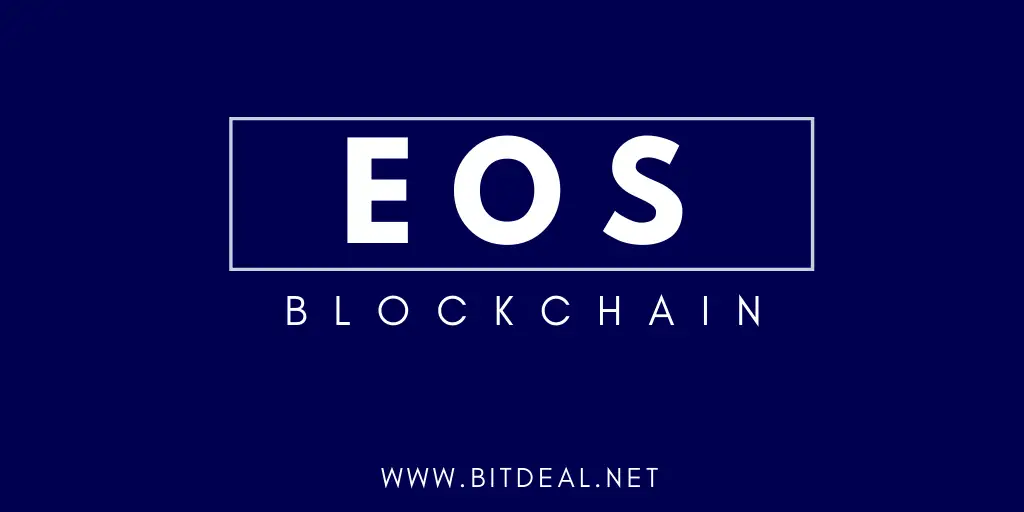Blog | Blockchain
What Is EOS? How Does EOS Blockchain Work?
Get high-end EOS Blockchain Development Services at bitdeal. Also, learn What is EOS and its Consensus Algorithm
- Blogs

Eos blockchain development

Blockchain has a great spark and got double the hype when creating a separate blockchain network for various industries. It all set to take up in 2008, a mysterious peer to peer cryptocurrency-based financial system called Bitcoin and it has paved a way for a technology called Blockchain. Now Blockchain- technology which has resulted in a great breakthrough for its highly secured features and functionalities and it is moving far beyond cryptocurrencies.
Over the Evolution of Blockchain Ecosystem, here aroused various blockchain networks such as Ethereum, TRON, Steller, Waves and so on. Now the EOS is in the queue up. Other than any other blockchain EOS seems to be more supportive of developing blockchain applications, tokens, dapps and more.
EOS Dapp Development
The process of Creating, Deploying and publishing any decentralized applications on the layers of the EOS Blockchain framework can be defined as the EOS Blockchain Dapp Development. Blockchain Development Companies like Bitdeal are taking over the advantages of EOS Blockchain to facilitate the client’s requirement on EOS Blockchain Development. Since EOS is a free, open-source blockchain network it provides developers a free space to develop decentralized applications. Just like any other network EOS is also having some own and unique development protocols. Developers who decided to develop an application on EOS must comply with the community rules.
Hope you now got an overview of EOS blockchain dapp development now let’s dive deep into the concept of EOS Blockchain so that we can understand more in detail.
Let us get into the topic here!!
What is EOS?
EOS is the popular Blockchain Technology, based on the Decentralized platform that was founded in 2017. This Blockchain Platform is to support the wide-scale of industrial Decentralized Applications, which is also designed similar to, as well as more than that of Ethereum Blockchain core functionalities.
The Objective of the EOS
-
To Support Decentralized Applications (DApp)
-
To remove the Transaction Fees.
-
To conduct millions of transactions every second.
Agreed to be that the World's seventh largest blockchain is EOS with a high value of $3billion by Market Cap, since February 2019.
Here the EOS Blockchain will give you the best Smart contract functionality and also offers you an environment with high-end security and authentication. This EOS Blockchain Platform also provides you an Operating system with a handful of services and functionalities that is necessary for Decentralized applications.
Like most blockchains, EOS also has its own native cryptocurrency named as EOS.
How Does EOS Work?
This EOS Blockchain Platform provides an Operating system with services that includes server hosting, cloud storage, and user authentication, and work by Delegated Proof of stake
Scalability and Usability is the major drawback of Blockchain Technology, Isn’t it?
It turned out to be a situation where the rate of transaction speed with Ethereum is extremely low. Hence here, EOS played a wide role of "Ethereum Killer" that is it will work as Ethereum and also beyond that of Ethereum. Of course, both Ethereum and EOS have the capability to build a dApp on it, supported by smart contracts.
Normally, users need to pay the GAS fees to the dApps that is built on the Ethereum Platform. Now it has been eliminated by the EOS platform as it enables its users to build dApp on the platform for free.
In terms of the dapp activeness,
- 95% of the EOS dapps remained active—with 326 out of the 341 dapps had transactions in the 1st quarter.
- More than 80% of dapps that were built on the Steem and TRON are had, active users.
To process the data the ethereum technology supports Proof of work, whereas the EOS platform uses Delegate Proof of Stack to increase its transaction speed.
Reference: bitdegree.org
Proof of Work and Delegated proof of Stake
Proof of Work
Initially, proof of work was originally published in 1993.
Producing a proof of work involves solving a mathematical puzzle, this puzzle is solved by the miners and the one who finds the solution will get the miner reward.
The process of inserting the Blocks of blockchain requires high computing power and electricity.
Delegated Proof of Stake
The Delegated Proof of Stake is the rework of Proof Stake
One alternative method suggested to proof of work concept is proof of stack which is suggested on the bitcoin forum in 2011.
The PoS replaces miners with validators, and ask validator to hold up certain coins as stake.
In proof of stack, a validator can validate the transactions based on the number of cryptocurrencies he/she holds.
Meaning the more bitcoins you own the more bitcoin mining power you have.
For example, if you own 10% of bitcoin then you can 10% of the transaction.
Know More about Consensus Algorithm!!
How Does Delegated Proof of Stack work in EOS?
-
As I said earlier, here validator have to hold up certain coins as stake
-
There will be 21 rounds, and in every round, blocks will be produced.
-
There will be a selection of 21 block producers at every round.
-
The first 20 members are chosen automatically and the final 21st person is selected proportional to the number of their votes relative to the other producers.
-
Then the producers are shuffled around to get a fair opportunity.
-
Every 24 hours the producer has to produce at least one block.
-
This DPoS makes the transaction fast and cheap and blocks time is kept to 3 seconds.
Features of EOS Blockchain
Scalability
Scalability is based on the processing of the network at a given time. With the adoption of Delegated Proof of stake, EOS blockchain gained millions of transaction per second
Flexibility
In 2016, a code vulnerability has occurred in Ethereum, due to the hard fork the system got standstill everything has stopped. hence with the help of the DPOS Consensus mechanism the EOS will provide security from that kind of vulnerabilities.
Usability
The EOS blockchain provides complete features like web toolkit for development interface and self-describing information schemas
Governance
Multiprocessing
Self Evolution
And so on..
Bitdeal - EOS Blockchain Development company
Being as one of the best EOS Blockchain Development Company, having a team of experts in creating highly Advanced EOS blockchain solutions to satisfy the new trends of industry-specific needs, also having a success rate of project deliverability all over the globe.
Stay Connect with our team of Blockchain Developers to know the potential various Blockchain Networks.
Our Blockchain Development Services
-
Private Blockchain Development
-
Smart Contracts Development
-
Token Development
-
DApp Development
-
Hyperledger Development
-
POC Blockchain Development
-
Exchange Application Development
Get A Demo
We are glad to announce that, Bitdeal is making one more milestone in its journey. As Web3 technologies becomes more dominant and lucrative, bitdeal sets its footmark in AI and Gaming Space. Explore our all-new AI and Gaming Solutions below here.